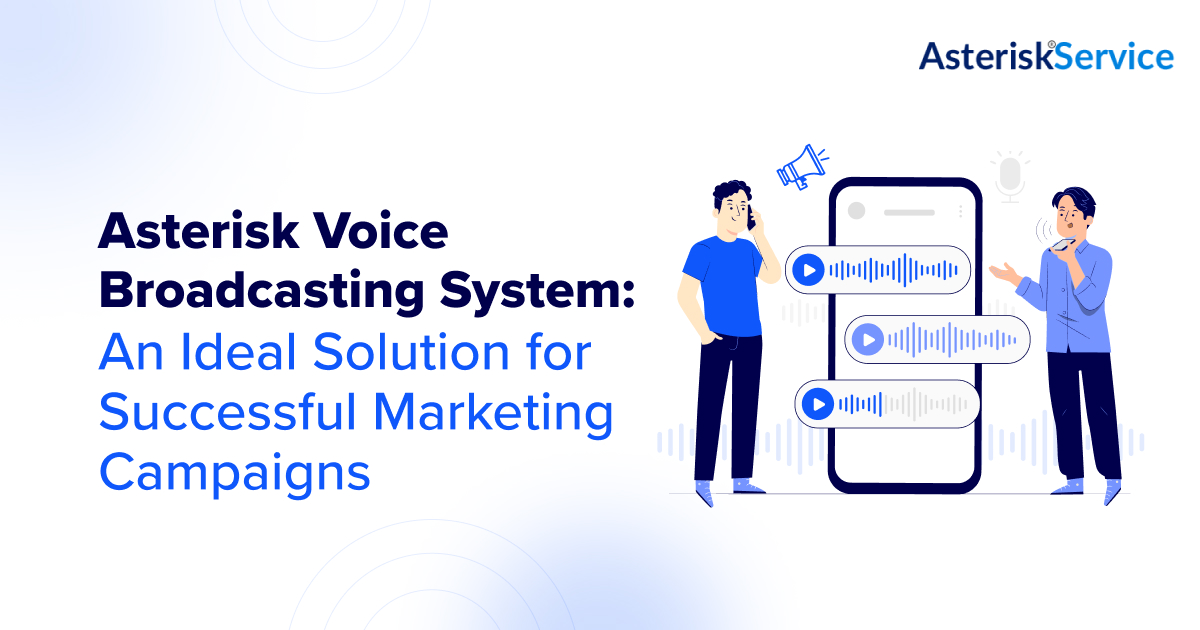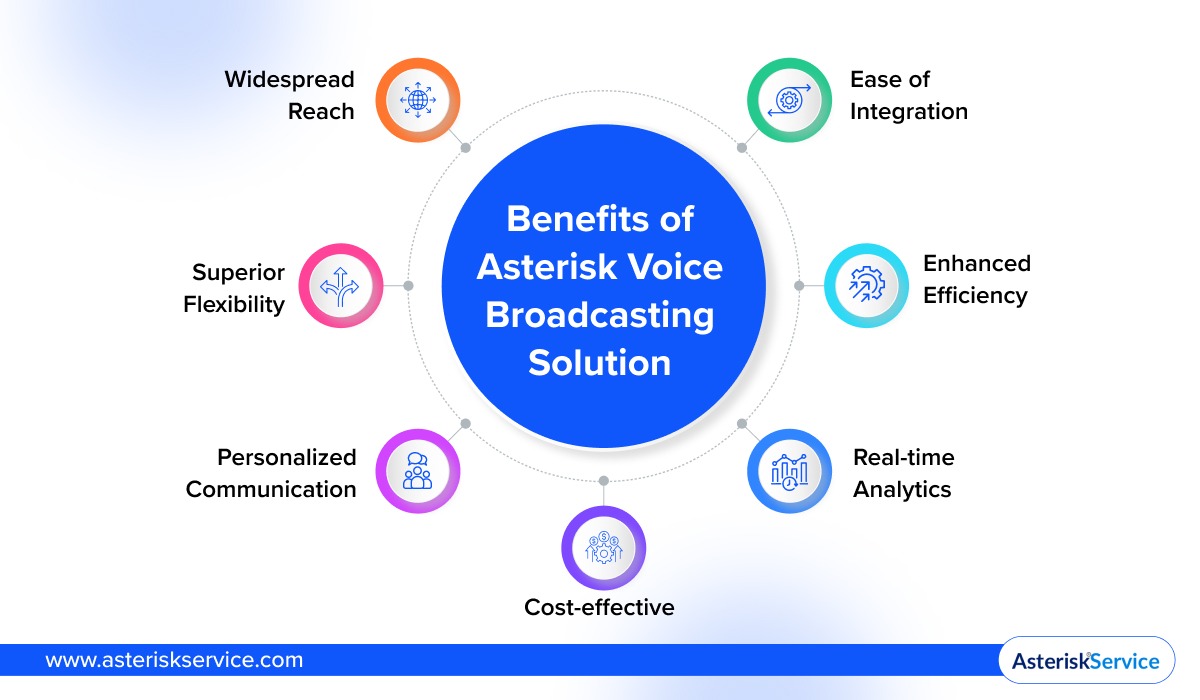
Quick Summary: Asterisk Voice Broadcasting is a cost-effective, efficient solution for global marketing campaigns, enhancing customer engagement with personalized automated voice messages and detailed performance analytics.
In today’s highly competitive marketplace, businesses must frequently launch marketing campaigns to generate brand awareness and drive sales. With various media channels available—including voice, print, television, and online platforms—choosing the right medium is crucial for connecting with specific customer segments. One highly effective and widely used method is Voice Broadcasting, a technique that allows businesses to reach numerous potential customers without extra human effort. This advanced, real-time approach ensures direct engagement with customers, minimizing the chances of ignored messages. This article delves into the intricacies of Voice Broadcasting, particularly the Asterisk Voice Broadcasting solution, and how it can revolutionize your marketing campaigns.
What is Voice Broadcasting?
Voice Broadcasting, also known as robo-calling, auto-dialing, or mass calling, is a mass communication technique that enables organizations to send pre-recorded audio messages to large audiences simultaneously. This method can be used for both commercial and community applications, making it a versatile tool for various sectors. By leveraging a voice broadcast system, businesses can send out important notifications, promotional messages, and reminders efficiently.
Voice Broadcasting is one of the most popular and easiest ways to broadcast an automated voice message to a large number of call recipients at once. It can be defined as a mass communication technique that businesses largely adopt while running a marketing campaign. This broadcasting system is an ideal solution for businesses to promote attractive deals and offers related to their products and services to their existing as well as potential customers. The solution can also be used to perform surveys and collect useful information from customers across different regions without incurring significant expenses. Overall, with the Voice Broadcasting technique, businesses can save time, increase revenue, and enhance customer satisfaction.
How Does the Voice Broadcasting System Work?
Understanding how a Voice Broadcasting system works is essential for leveraging its full potential. A Voice Broadcasting system automates the process of sending pre-recorded messages to a large number of recipients. Here is a step-by-step explanation of the process:
1. Contact List Upload
Visualize a person uploading a formatted CSV/Excel file containing phone numbers into a web-based interface.
-
- Compiling the List: Businesses start by compiling a comprehensive list of target audience phone numbers. This list can be generated from CRM databases, customer sign-ups, or purchased marketing lists.
- Formatting the Data: The contact list needs to be formatted according to the system’s requirements. This typically involves organizing the numbers in a CSV or Excel file with appropriate headers.
- Uploading to the System: Users upload the formatted contact list into the Voice Broadcasting system. This step often involves using a web-based interface where the file can be imported. The system validates the list to ensure that all numbers are correctly formatted and identifies any duplicates or invalid entries
2. Recording the Message
A person recording a message using a microphone, or uploading an audio file, with options for text-to-speech visible.
-
- Message Content Creation: Businesses create the content of their message. This can range from promotional messages about new products or services, reminders for appointments, surveys for customer feedback, or urgent notifications.
- Recording Options: The message can be recorded in several ways. Users can either record the message using a built-in microphone, upload an already recorded audio file, or use text-to-speech technology provided by the system to generate the message.
- Editing and Finalizing: Once the message is recorded, it can be edited for clarity and impact. Users can add pauses, change the tone, and ensure the message is concise and clear. Some systems allow for adding dynamic elements, such as personalized greetings or customer-specific information.
3. Setting Preferences
A settings panel showing options like scheduling, retry logic, answering machine detection, DNC compliance, and interactive options.
-
- Scheduling the Broadcast: Users can schedule the broadcast for a specific date and time, ensuring the message is delivered at the optimal moment for the target audience. This is particularly useful for time-sensitive campaigns or reminders.
- Retry Logic: Users set the number of retries for calls that go unanswered or encounter a busy signal. This ensures that the message reaches as many recipients as possible.
- Answering Machine Detection: The system can be configured to detect answering machines. If an answering machine is detected, the system can either leave a message or disconnect the call based on user preference.
- DNC Compliance: Users can set preferences to comply with Do Not Call (DNC) lists, ensuring that the campaign adheres to legal regulations. Recipients should have the option to opt out of future calls.
- Interactive Options: For more advanced campaigns, users can integrate Interactive Voice Response (IVR) elements, allowing recipients to interact with the message (e.g., press 1 to speak to a representative, press 2 for more information).
4. Launching the Campaign
The system initiates a call blast with a dashboard displaying real-time progress and adjustments.
-
- Final Review: Before launching, users review all settings and ensure the contact list, message, and preferences are correctly configured. This step minimizes the risk of errors during the broadcast.
- Initiating the Call Blast: The campaign is launched by initiating the call blast. The system starts dialing the numbers on the contact list simultaneously or in batches, depending on the system’s capabilities and the user’s settings.
- Real-time Adjustments: During the campaign, users can monitor the progress in real-time. Some systems allow for on-the-fly adjustments, such as pausing the campaign, changing the message, or modifying retry settings based on initial feedback.
5. Monitoring and Reporting
-
- Real-time Monitoring: Users can monitor the progress of the campaign in real-time through a dashboard provided by the system. This includes tracking the number of calls made, successful connections, and responses received.
- Detailed Reports: After the campaign, the system generates detailed reports that provide insights into the campaign’s performance. This includes metrics such as the total number of calls, successful deliveries, messages left on answering machines, call durations, and any interactive responses.
- Analyzing Results: Businesses can analyze these reports to measure the effectiveness of the campaign. This analysis helps in understanding the reach, engagement, and overall impact of the broadcast. Insights gained can be used to refine future campaigns.
A smart voice broadcast system is capable of detecting an automatic answering machine. When the call is answered by the machine, the system will either play the message or hang up the call. This automation makes the process highly efficient, requiring minimal human intervention. The ability to detect and respond to answering machines ensures that the message reaches the intended recipient effectively, increasing the overall efficiency of the campaign.
Key Features of Voice/Audio Broadcasting System
A robust Voice Broadcasting system, such as the Asterisk software, comes with a range of features designed to enhance its functionality and usability. Here are some key features:
-
- User-friendly Interface: An intuitive interface that simplifies the process of setting up and managing broadcast campaigns.
- Supports Simultaneous Calls: The ability to handle multiple calls at once, ensuring that large audiences can be reached quickly.
- Personalized Messages: The capability to personalize messages with recipient-specific information, making the communication more relevant and engaging.
- Answering Machines Detection: Automatic detection of answering machines and appropriate handling of such calls.
- DNC and Opt-out Support: Features that ensure compliance with Do Not Call (DNC) lists and provide recipients with options to opt-out of future calls.
- Auto Redial Feature: Automatic redialing of numbers that were busy or did not answer the first time.
- Supports Interactive Voice Response (IVR): Integration with IVR systems to allow recipients to interact with the message, such as pressing keys to provide responses.
- Call Report Notifications: Real-time notifications and detailed reports on the status and outcomes of the broadcast campaign.
- Web-based Call Detail Reports: Access to detailed call reports through a web interface, providing insights into the performance of the campaign.
- Easy Import of Contacts: Simple tools for importing contact lists from various sources.
- Handles Multiple IVR Scripts: The ability to manage and switch between multiple IVR scripts within the same campaign.
- Live Call Transfer: Option to transfer calls to a live agent if the recipient wishes to speak to someone directly.
These features collectively ensure that the Voice Broadcasting system is not only efficient but also versatile, providing businesses with a powerful tool for their marketing and communication needs.
Benefits of Asterisk Voice Broadcasting Solution

Utilizing a broadcast offers numerous advantages for businesses. Here are some of the major advantages given below:
- Widespread Reach: Businesses can reach a large number of customers, regardless of their geographical location, making it an ideal tool for global campaigns.
- Superior Flexibility: The system allows businesses to customize various aspects of the campaign, including the timing of the calls, message content, and campaign duration.
- Cost-effective: Compared to other marketing methods, custom multi-tenant broadcasting solutions are highly cost-effective, providing excellent ROI by minimizing the need for manual labor.
- Personalized Communication: Businesses can create personalized messages in multiple languages, enhancing the relevance and impact of the communication.
- Ease of Integration: The Asterisk software can be seamlessly integrated with existing CRM systems, enabling efficient management of customer data and campaigns.
- Enhanced Efficiency: With automated dialing and message delivery, businesses can run large-scale campaigns with minimal human intervention, improving overall efficiency and productivity.
- Real-time Analytics: Access to real-time data and detailed reports allows businesses to monitor the performance of their campaigns and make data-driven decisions.
The Asterisk Voice Broadcasting solution empowers businesses with the tools they need to efficiently and effectively reach their target audience, ensuring personalized and impactful communication.
Final Thoughts
In a Nutshell, the Asterisk Voice Broadcasting system is an exceptional solution for businesses looking for an efficient and cost-effective way to conduct marketing campaigns. This advanced technology not only enhances customer engagement but also drives significant improvements in sales, brand awareness, and overall marketing effectiveness. By leveraging the power of Voice Broadcasting, businesses can reach their target audiences more effectively, making it a vital tool in today’s competitive marketplace. For businesses seeking to implement this technology, Asterisk Service offers comprehensive solutions tailored to meet specific needs. Our expertise in Asterisk software ensures that you get the most out of your Voice Broadcasting campaigns, driving your marketing efforts to new heights.
FAQs
1. What is Asterisk software used for in Voice Broadcasting?
Asterisk software is used in Voice Broadcasting to manage and automate the delivery of pre-recorded messages to a large number of recipients. It helps businesses execute efficient and cost-effective marketing campaigns, ensuring messages reach the target audience effectively.
2. How does an automated voicemail system benefit businesses?
An automated voicemail system benefits businesses by streamlining communication, reducing manual labor, and ensuring consistent message delivery. It allows businesses to send personalized and timely messages to customers, improving engagement and response rates.
3. How does voicemail broadcasting work in marketing campaigns?
Voicemail broadcasting works in marketing campaigns by sending pre-recorded promotional messages to a list of target customers. This method allows businesses to efficiently reach a large audience, provide timely information about products or services, and collect customer feedback, all with minimal human intervention.
4. What is the advantage of using an IVR Voice Broadcasting system?
The benefit of using an IVR Voice Broadcasting system is that it enables interactive communication with customers. Recipients can respond to prompts, providing valuable feedback or routing themselves to the appropriate department, which enhances customer engagement and satisfaction.
5. How can Voice broadcast marketing improve ROI for businesses?
Voice broadcast marketing improves ROI for businesses by reducing the costs associated with manual outreach, ensuring timely and accurate message delivery, and increasing customer engagement. The automation and efficiency of Voice Broadcasting allow businesses to reach more customers with fewer resources, leading to higher conversion rates and better overall campaign performance.